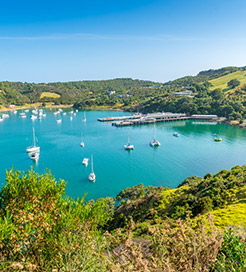
-
Recent Searches
Recent Searches
- My Account
- Customer Service
-
Canada

Ferry from Waiheke Island to New Zealand
There are 2 ferry routes operating between Waiheke Island and New Zealand offering you combined total of 37 sailings per day. Fullers Ferry operates 1 route, Waiheke to Auckland which runs 24 times daily. Sealink NZ operates 2 routes, Waiheke to Auckland runs 3 times per day & Waiheke to Half Moon Bay (Auckland) about 10 times daily.
As the frequency and duration of crossings on some routes varies we would advise that you do a live search for crossings from Waiheke Island to New Zealand to get the most up to date information.
Route map
Ferries from Waiheke Island to New Zealand
-
- Fullers Ferry
- Get price
-
- Sealink NZ
- Get price
-
- Sealink NZ
- Get price
About Waiheke Island:
Waiheke Island sits roughly 18 kilometres east of Auckland, New Zealand in the Hauraki Gulf.
Although it lies close to country’s capital city, the peaceful Waiheke Island boasts its own dry and warm microclimate, making it the ideal weekend getaway for city-dwellers on the mainland.
As part of the Hauraki Gulf Marine Park, there are some excellent areas for swimming and snorkelling, particularly in White’s Bay and Otakawhe Bay. The coastline is also blessed with some immaculate sandy beaches.
Known locally as ‘the island of wine’, Waiheke has a large number of top quality vineyards and wineries, too, which are well worth visiting so be sure to organise a guided tour.
As one of the most popular day trip destinations in the Hauraki Gulf, there are numerous ferry routes back to Auckland lasting around 40 minutes, to both Auckland Harbour and Devonport.
About New Zealand:
New Zealand is a small country, similar in size to Great Britain or Japan. With a population of only four million people it’s gloriously un-crowded and many areas are sparsely settled.
Consisting of two main islands - imaginatively named North Island and South Island and many smaller islands in the South Pacific Ocean, the archipelago lies roughly 1,000 miles south east of Australia.
New Zealand has a temperate climate. Winters are fairly cold in the south of the South Island but mild in the north of the North Island.
Known by some as "The Shaky Isles" because of frequent seismic activity, lying on the margin of the two colliding tectonic plates (the Pacific and Indo-Australian), earthquakes are common, particularly in the south west of the South Island and in the central North Island. As a result, the North Island's scenery is marked by several active and dormant volcanic cones.
Wellington is the capital of New Zealand. The Windy City is built on the foreshore of Wellington Harbour and ringed by mountains, providing the scenic home of many of New Zealand's national arts and cultural attractions.


